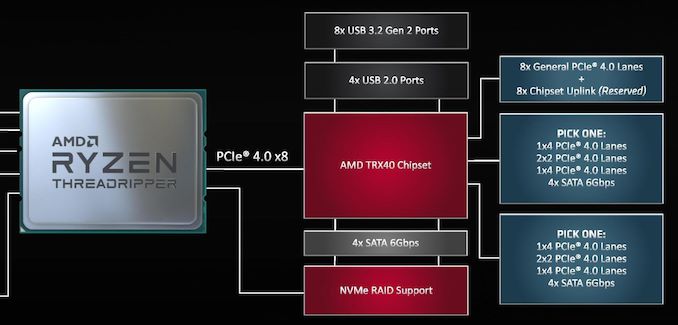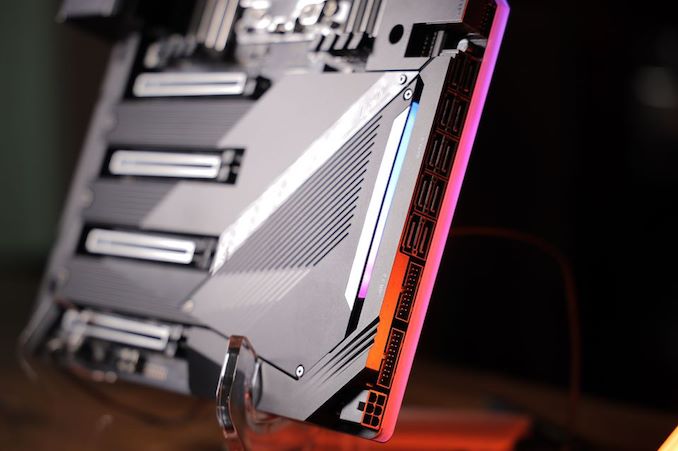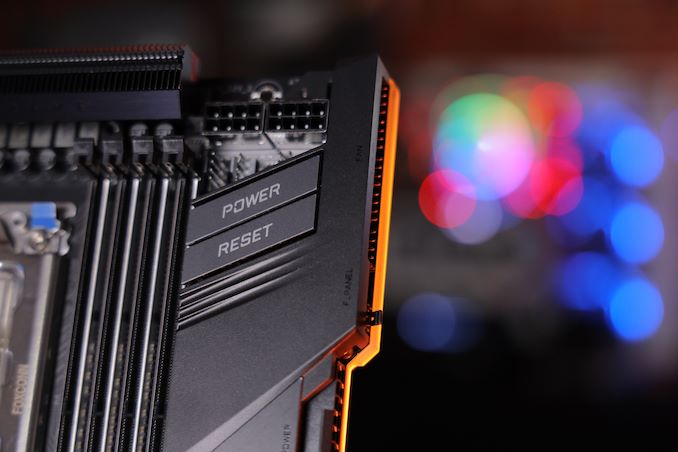AMD Q4: 16-core Ryzen 9 3950X, Threadripper Up To 32-Core 3970X, Coming November 25th
by Dr. Ian Cutress on November 7, 2019 9:00 AM ESTTRX40: More High-End Motherboards for TR3
The new sTRX4 socket will be paired with a TRX40 chipset – a design that AMD says comes from an in-house team and built on GlobalFoundries 14nm. The new chipset, updated from the previous X399 in this space and even updated from the X570 in the consumer space, is the other half in the CPU-to-chipset bandwidth story. By using a PCIe 4.0 x8 link, AMD is removing almost any practical bandwidth limitation downstream from the CPU.
The new TRX40 chipset will come with a degree of modularity.
From the chipset, we can see motherboard manufacturers afforded a full PCIe 4.0 x8 slot, up to another x8 lanes as two x4 connections or further bifurcated, or instead of those bifurcated lanes, either four or eight more SATA ports. That’s 8 SATA ports on top of the four already present on the chipset.
So I like these modular systems. It allows motherboard manufacturers to go crazy with offering potential systems. For example:
| Potential TRX40 Variants | |||||||
| AnandTech | CPU | Chipset | |||||
| TRX40 SATA Powerhouse 20 drives |
x48 for PCIe slots | x8 for downlink | 8x SATA from options | x8 for dual NVMe | 8x SATA from options | 4x SATA from chipset | |
| TRX40 NVMe Powerhouse 18+ drives |
x48 for PCIe slots | x8 for downlink | dual NVMe from options | x8 for dual NVMe | dual NVMe for options | - | |
So that would be a motherboard with x16/x16/x16 (or x16/x8/x16/x8) in terms of PCIe 4.0 slots, a single x8 slot for a pair of NVMe drives, and then TWENTY SATA ports, all directly supported on the system without any additional controllers.
If SATA isn’t your thing, then the same arguments could be made for 48 PCIe lanes and six PCIe 4.0 x4 NVMe slots, making a total of 18 high capacity PCIe 4.0 drives. The fact that AMD has put more PCIe lanes into their high end desktop platforms, plus this amount of modularity, wants me to play Dr. Frankenstein.
To be fair, those ideas are a bit extreme. Motherboard manufacturers will likely have to partition off a few lanes for 10 GbE networking, perhaps Thunderbolt, or maybe something more exotic like a RAID controller, or an RGB controller.
As noted in some of our previous news posts, motherboard manufacturers have been slowly leaking names of their TRX40 products. At this point in time we have seen mentions of the following:
- ASRock TRX40 Creator
- ASRock TRX40 Taichi
- GIGABYTE TRX40 AORUS XTREME
- ASUS Prime TRX40 Pro
- ASUS ROG Zenith II Extreme
- MSI TRX40 Creator
- MSI TRX40 Pro 10G
- MSI TRX40 Pro Wi-Fi
We expect details of some of these to perhaps be announced today, or on the 25th when the CPUs come to market. GIGABYTE has even been showing previews of their motherboards on social media, with one showing an obscene number of power phases, and we’ve seen images of boards with 8 SATA ports. We’ll have our usual motherboard overview article up on that date, and we’ll be looking at reviews of these motherboards through the new year.
I will address comments about potential TRX80/WRX80 motherboards which have been put into the ether as potential other chipsets being launched. When asked, AMD said that the only chipset they are launching today is TRX40.













171 Comments
View All Comments
extide - Thursday, November 7, 2019 - link
Dependson your workloads. Both my desktop and work laptop have 64GB and I want to move my desktop at home to 128GB soon.close - Thursday, November 7, 2019 - link
I have a machine with 1024 cores and 2TB or RAM (no joke). I think the point of the comment above was that you don't *need* 64GB just because you need a TR.voodoobunny - Thursday, November 7, 2019 - link
... what do you *do*, and how can we do that too?imaheadcase - Thursday, November 7, 2019 - link
That is why these new CPUs are a slippery slope for people. At the end of the day even the hardcore gamer really has no incentive to upgrade past a CPU like the 2600K from Intel that was so popular. AMD is trying to put the "business" and "consumer" cpu in different category, but every year it seems kind of comical in most regards. Not saying that they don't have a advantage, but like you said the performance is getting to the point that you will not actually care about Mhz or core count, and more of feature sets of the CPU.Case in point:
"3.5 GHz base frequency and a 4.7 GHz single core boost frequency; the overall all-core turbo frequency will be dependent on the motherboard used, the quality of the silicon, and the turbo in play."
The last CPU i had boost was a 486dx intel cpu that went from 33mhz to 66mhz Boosted..even at that time i remember the controversy of it all. What i'm saving is when you get to a point that you have so many cores and are itching for a measly 100mhz or so its time to focus on integrating new tech into the cpu.
zmatt - Thursday, November 7, 2019 - link
Maybe your memory is foggy but the turbo on the 486 was a misnomer. It didn't make the cpu faster. 66mhz was the base clock. It halved the multiplier to run the cpu at 33mhz for games that didn't use the rtc. Many DOS games didn't support polling system time from the rtc because a lot of 386 and earlier systems didn't have them. So they kept time relative to the cpu cycles as a work around. I remember Liero did this and anything faster than a 16mhz 386 made the game actually run faster, to the point of unplayability. Unclocking the 486 via the turbo button helped, although on some games not enough.FreckledTrout - Thursday, November 7, 2019 - link
True. They all just misnamed the button turbo :) Which even back in the the 286 days I had a turbo button it of course worked as you described albeit lower frequencies.Xyler94 - Thursday, November 7, 2019 - link
There's more to a PC than raw CPU power.Platform features like PCIe version, SATA version, NVMe, some things that weren't even a sparkle in the eyes of engineers back in the Sandybridge days. Sure, if you only game, there's not too much of a difference, but there is a good one to say no to Sandybridge era CPUs in modern times. Hell, I wanna upgrade my 4790k, which is 3 years younger than Sandy Bridge.
The hardcore gamer have a lot of reasons to upgrade from Sandy, CPUs are faster, have more features, and newer stuff works better for newer OSs and such.
Threska - Thursday, November 7, 2019 - link
Instructions the earlier CPU didn't.**Reason I had to upgrade. The DRM needed it.
FreckledTrout - Thursday, November 7, 2019 - link
You have a point for the average person, CPU performance is pretty much a commodity. It took awhile but we have hit a point where people can reasonably afford more compute power than they need. However people who do real work like say video editing and don't have server farms these advances have been huge as they can never have to much compute.Spunjji - Friday, November 8, 2019 - link
This hasn't been true for around 2-3 years now, depending how you measure. Sandy had a long life (mainly thanks to its extremely conservative clock rates at stock) but it's way outside what I'd recommend to anyone looking to game even moderately seriously now.